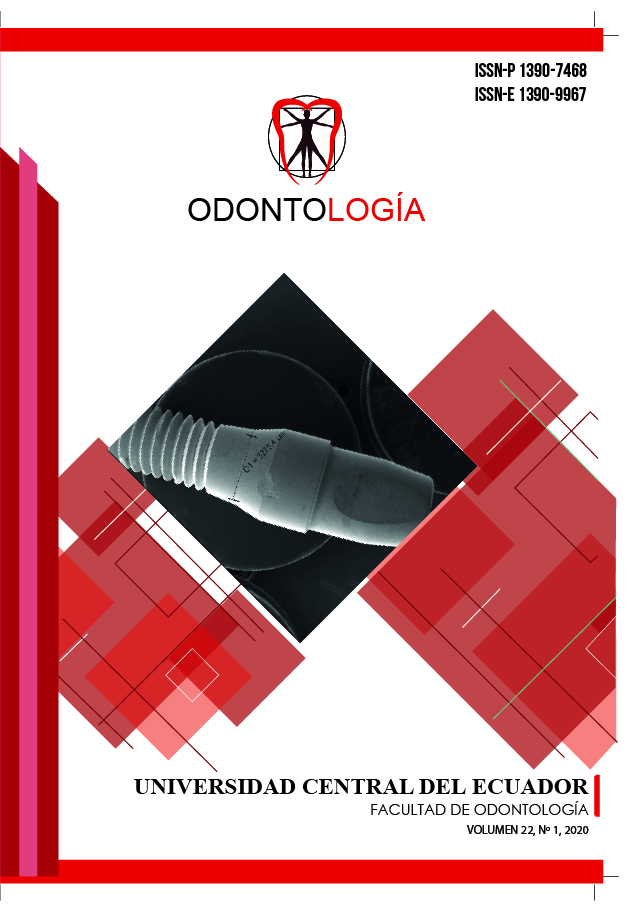Clinical considerations in a patient with mint muscle hi-pertonicity. Caso report
DOI:
https://doi.org/10.29166/odontologia.vol22.n1.2020-93-103Keywords:
Muscular hypertonia, bad occlusion, neuromuscular manifestations, angle class II malocclusionAbstract
In orthodontics It’s of relevant importance to create an aesthetically pleasing and functional occlusion, in addition to achieving and preserving the optimal facial attractiveness; It is mandatory to perform a thorough facial exam because the balance and harmony of the different parts of the face is determined by soft and soft tissues. The objective of this article is to expose the importance of a comprehensive diagnosis at the time of treatment planning. The present case relates the orthodontic management with Roth philosophy of a 13-year-old Latina patient, diagnosed with a class II skeletal relationship, excessive incision of the incisors in both arches, convex profile and chin-hypertonicity. The treatment plan was planned to correct the skeletal class II by extractions of the first 4 premolars. As a result, muscular hypertonicity was eliminated, obtaining adequate lip competence and the facial profile was improved in a period of 18 months. The management of this case is successful thanks to a correct diagnosis and the planning of the case, allows to demonstrate that not only are the bone and dental structures orthodontic objectives, but also those that help improve the patient's facial profile. It was necessary to evaluate the relationship of the lips and chin since these can be altered with orthodontic treatment.
Downloads
References
Sercan Alkyacin et al. Smile esthetics: Evaluation of long-term changes in the transverse dimensión. Korean J Orthod 2017;47(2):100-107
Shikha Singh, Sonali Deshmukh. Mean values of Arnett's soft tissue anal-ysis in Maratha ethnic (Indian) population — A cephalometric study. J Int Soc Prev Community Dent. 2016 Jul-Aug; 6(4): 327
Arnett, W., & Gunson, M. (2004). Facial planning for orthodontists and oral surgeons. American Journal of Orthodontics and Dentofacial Orthopedics, 290-295.
Bergman, R. W.-F. (2014). Longitudinal study of cephalometric soft tissue profile traits between the ages of 6 and 18 years. Angle Orthodontics, 48-55.
Sergio Paduano, Roberto Rongo, , Rosaria Bucci, Giuseppe Carvelli and Iacopo Cioffi. Impact of functional orthodontic treatment on facial attractive-ness of children with Class II division 1 malocclusion. European Journal of Orthodontics, 2019, 1–7.
Min-Ho Junga ; Won-Sik Yangb ; Dong-Seok Nahmb. Maximum Closing Force of Mentolabial Muscles and Type of Malocclusion. Angle Orthod 2010;80:72–79.
Nisa Guel Amuk, and co. Effects of Different Head Positioning Methods on Facial Soft Tissue Analysis Using Stereophotogrammetry. 2019 American Association of Oral and Maxillofacial Surgeons J Oral Maxillofac Surg 77:1277.e1-1277.e10, 2019
Fernandez VJM. A study of the development of the orbicularis oris muscle. Plast Reconstr Surg. 1975;55: 205–213
Nomura M, Motegi E, Hatch JP, et al. Esthetic preferences of European American, Hispanic American, Japanese and African judges for soft-tissue profiles. Am J Orthod Dentofacial Orthop 2009;135:S87–95.
Rashna Hoshang Sukhiaa, Hoshang Rumi Sukhiab, Syed Iqbal Azamc, Mubassar Fidad, Munizeh Khane. Chin Position: to treat or not to treat. In-ternational Orthodontics 2017 ; X : 1-9
Spalding P. Treatment of Class II malocclusion. In: Bishara SE, ed. Text-book of Orthodontics. Philadelphia, Pa: WB Saunders; 2001:324–374.
Jin-Hyoung Cho,a Eun-Jung Kim,b Byeong-Chae Kim,c Ki-Hyun Cho,d Ki-Heon Lee,e and Hyeon-Shik Hwang Correlations of frontal lip-line canting with craniofacial morphology and muscular activity. Am J Orthod Dentofa-cial Orthop 2007;132:278.e7-278.e14
Sarver DM, Ackerman MB. Dynamic smile visualization and quantification: part 1. Evolution of the concept and dynamic records for smile capture. Am J Orthod Dentofacial Orthop 2003;124:4-12.
Sarver DM, Ackerman MB. Dynamic smile visualization and quantification: part 2. Smile analysis and treatment strategies. Am J Orthod Dentofacial Or-thop 2003;124:116-27.
Auger TA, Turley PK. The female soft tissue profile as presented in fashion magazines during the 1900s: a photographic analysis. Int J Adult Orthod Orthognath Surg 1999;14:7-18.
Arnett, W., & Bergman, R. Facial keys to orthodontic diagnosis and treat-ment planning. Part I. American Journal of Orthodontics and Dentofacial Orthopedics, 1993. 299-312.
Matta, C., & Sagawa, J. Comparación entre la zona facial media y el tercio facial inferior en estudiantes de 19 a 25 años de edad de la FacuItad de Estomatología de la UPCH. Revista Estomatológica Herediana, 13 (2-3), 23-26, 2003.
Bader HI. Soft-tissue considerations in esthetic dentistry. Compendium 1991;12:534, 536-8, 540-2.
Spalj S, Slaj M, Varga S, Strujic M, Slaj M. Perception of orthodontic treat-ment need in children and adolescents. Eur J Orthod 2010;32:387–94.
Craig R. Scott,a Mithran S. Goonewardene,b and Kevin Murrayc Influence of lips on the perception of malocclusion. Am J Orthod Dentofacial Orthop 2006;130: 152-62
Sukhia RH, Khan M, Fida M, Shaikh A, Azam SI. Esthetic preferences for facial soft tissue profiles. Int J Orthod Milwaukee 2011;22:17–23.M.
Guttafsson and J. Ahlgren. Mentalis and Orbicularis Oris Activity in Cbiktren With Incompetent Lips: An Electromyographic and Cephalometric Study. Acta Oaontol. Soanrl. 33:1975
Sarver DM, Ackerman JL. Orthodontics about face: the re-emergence of the esthetic paradigm. Am J Orthod Dentofacial Orthop 2000;117:575–6.
Published
How to Cite
Issue
Section
License
Copyright (c) 2020 Pamela Garrido Villavicencio, Abigail Perez Charles, Vladimir Ramirez

This work is licensed under a Creative Commons Attribution-NonCommercial-NoDerivatives 4.0 International License.


